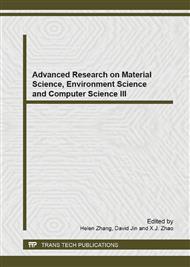[1]
Diamanti-Kandarakis E, Bourguignon J-P, Giudice LC, Hauser R, Prins GS, Soto AM, et al. Endocrine-disrupting chemicals: an Endocrine Society scientific statement. Endocrine Reviews. 2009, vol. 30: pp.293-342.
DOI: 10.1210/er.2009-0002
Google Scholar
[2]
L. Ferreira-Baptista, E. De Miguel, Geochemistry and risk assessment of street dust in Luanda, Angola: a tropical urban environment, Atmospheric Environment, vol. 39, Aug. 2005, pp.4501-4512.
DOI: 10.1016/j.atmosenv.2005.03.026
Google Scholar
[3]
Ministry of Health of the People's Republic of China. Healthy statistical yearbook of China (In Chinese).
Google Scholar
[4]
Y. J. Chen, Y. M. Wen and S. W. Chai, The heavy metal content character of agricultural soil in the Pearl river Delta, Research of Environmental Sciences, vol. 18, May. 2005, pp.75-87.
Google Scholar
[5]
F. Yang, L. X. Bai, C. H. Liang, G. A. Wang, Q. Huang, J. Wen, et al, Investigation of the cadmium contamination on retailed rice and rice products in Guangdong province in 2009, Chinese Journal of Food Hygiene, vol. 23, Jul. 2011, pp.278-279.
Google Scholar
[6]
C. H. Zhang, X. L. Hu and G. Zhang, Invetigation on lead and cadmium contamination in foods, Practical Preventive Medicine, vol. 15, Jun. 2008, pp.875-876.
Google Scholar
[7]
S. P. Deng, Y. M. Luo, J. Song, Y. Teng and Y. S, Chen. Carcinogenic risk assessment of polychlorinated biphenyls and cadmium in multi-media of a typical area, Acta pedologica sinica, vol. 48, Jul. 2011, pp.731-742.
Google Scholar
[8]
Ministry of Health of the People's Republic of China. Healthy statistical yearbook of China (In Chinese). (2007).
Google Scholar
[9]
A. Gerhardt, Screening the toxicity of Ni, Cd, Cu, ivermectin, and imidacloprid in a short-term automated behavioral toxicity test with Tubifex tubifex (Müller 1774)(Oligochaeta), Human and Ecological Risk Assessment, vol. 15, Feb. 2009, pp.27-40.
DOI: 10.1080/10807030802614983
Google Scholar
[10]
Ministry of Health of the People's Republic of China. Healthy statistical yearbook of China ( In Chinese), 2008.
Google Scholar
[11]
F. Y. Zhai, Y. N. He, G. S. Ma, Y. P. Li, H. Z. Wang, Y. S. Hu, et al, Study on the current status and trend of fodd consumption among Chinese population, Chinese Journal of Epidemiology, vol. 26, Jul. 2005, pp.485-488.
Google Scholar
[12]
B. Hang, J. T. He, H. H. Chen, H. W. Shen and J. H. Shi, Primary study of health-based risk assessment of organic pollution in groundwater, Earth Science Frontiers, vol. 13, Jan. 2006, pp.224-229.
Google Scholar


